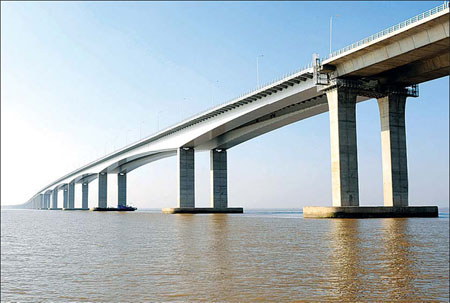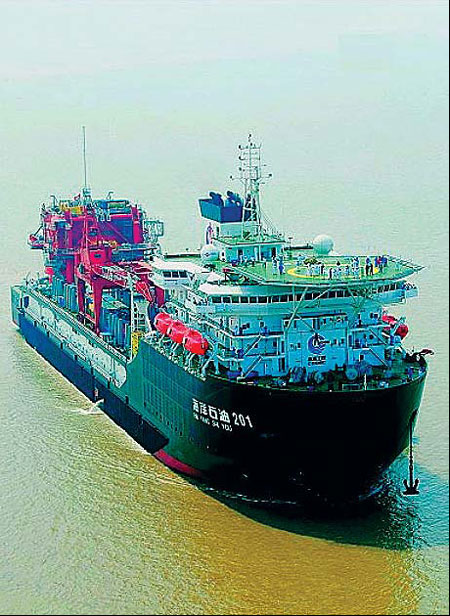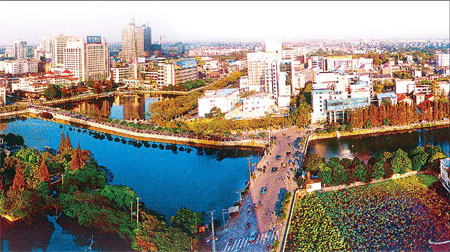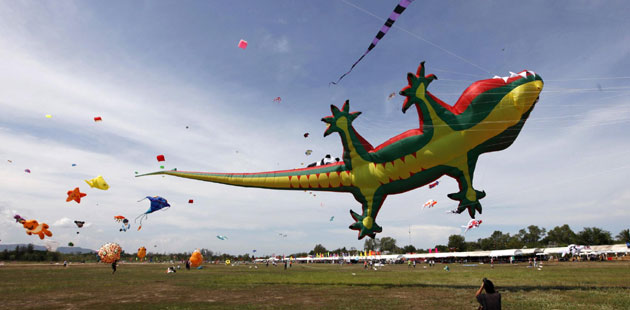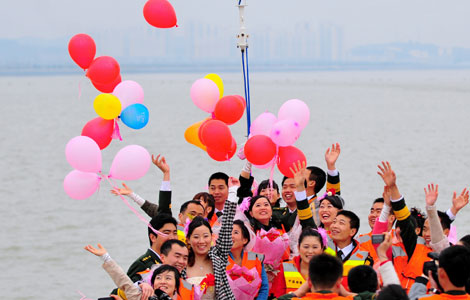Nantong: Robust growth, global challenges
Updated: 2012-03-05 08:11
By Ding Congrong and Gu Wenting (China Daily)
|
|||||||||||
|
The Chongming-Qidong Bridge has greatly shortened travel time to Shanghai. |
|
The deepwater pipe-laying vessel made in Nantong meets international standards. |
|
Only 90 km from Shanghai, Nantong is a prefecture-level city in Jiangsu province on the northern bank of the Yangtze River. |
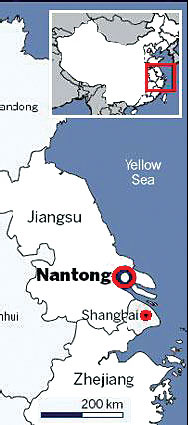
Rising GDP, investment and trade for city on the Yangtze
Despite global economic crisis, the coastal city of Nantong in northern Jiangsu province continues to post robust economic growth, ranking high among economies in the Yangtze River Delta as well as prefecture-level cities across China.
Local officials credit the achievement to overall development in the province and economic integration in the Yangtze River Delta.
The city of 7 million people is strategically placed in China's most developed region, only 90 km away from metropolitan Shanghai.
Nantong has received numerous national accolades including titles as civilized, clean, and as one of the best cities for tourism and investment by foreign enterprises.
Due to its favorable location at the mouth of the Yangtze, Nantong is a fast-rising star in the delta region, attracting investment from more than 40 Fortune 500 enterprises.
More high-tech industries and modern service industries are expected in the near future, officials said.
As the 12th Five-Year Plan (2011-2015) started, the world economy was beset with problems, yet Nantong made economic headway under the stewardship of a city government that emphasized coastal development, modernized industries and extensive investment promotion.
Last year Nantong's GDP grew 12 percent over 2010 to reach 410 billion yuan ($65.07 billion). Revenues from taxes and fees rose to 95.17 billion yuan, almost 40 percent of which went to the local general budget.
Other economic indicators in 2011 also pointed to rapid economic growth.
Fixed investment totaled 238 billion yuan, a 21.7 percent increase over 2010.
Total retail sales reached 148 billion yuan, a 17 percent increase, while its trade volume rose 18.5 percent to $25 billion.
Some $2.55 billion was invested by foreign enterprises that have business operation in the city in 2011.
Annual per capita net income for urban residents reached 25,100 yuan, a 15 percent increase over 2010.
Farmers' per capita net income reached 11,500 yuan, a 16 percent increase over 2010.
The increases came as the city posted a slower rise in the consumer price index than the provincial average.
The registered urban unemployment rate was only 2.8 percent, while investment in R&D totaled 2.05 percent of the city's GDP.
City officials said Nantong focused on increasing the amount and improving the structure of foreign capital last year to accelerate economic transformation.
More foreign investment was made in advanced manufacturing, high tech industries and modern services than in the past.
Foreign investment deals totaled $4.54 billion last year, $2.55 billion of it now invested. The city has had $2 billion to $3 billion realized foreign investment for six consecutive years.
The 23 newly approved foreign capital projects that each surpassed the $100 million benchmark represented a 35 percent rise over large projects the year before.
Twenty-seven foreign capital projects valued at $30 million or more in strategic new industries brought in $1.04 billion in contracts.
In the services sector, $605 million in foreign capital reached the city, a 30.4 percent year-on-year increase.
As it accelerates the transformation in its trade structure, Nantong posted higher growth in trade than the provincial average.
Its two-way trade volume is expected to exceed $25 billion, an 18.5 percent increase over the year before. Exports are projected to rise 24 percent to $17.5 billion.
The growth in two-way trade was 6 percent higher than the average in Jiangsu province, while exports grew 8 percent more than the average.
General trade comprised 57 percent of the total trade volume, 17 percent higher than the Jiangsu average.
Thirty percent of its exports went to emerging markets in Southeast Asia, the Middle East and Latin America, a 3 percent increase over 2010.
The city has 265 enterprises whose export volume exceeded $10 million last year and 14 enterprises whose export volume surpassed the $100 million mark.
Following a name change and upgrade, Nantong's development zone has been on a fast track to further development. The area is expected to generate 19 billion yuan in general budget revenue, a 31 percent increase over the year previous, and some 52 percent of the city's total.
With the Suzhou-Nantong Yangtze River Bridge and Chongming-Qidong Yangtze River Bridge now in use, Nantong is more convenient to reach from Shanghai, further boosting its business prospects.
City leaders said they recognize the world economy is expected to see further challenges in 2012, but the Yangtze Delta actually has ambitious goals for 2012.
The city's targets for various economic indicators have been specified. It aims to realize an 8.5 percent increase in export volume to $19 billion.
It also outlines several principles to attract more foreign capital. Policies include lower fees on enterprises, better facilities than other cities in the region and a commitment to the best government services.
The official said the city is striving to coordinate its various endeavors to ramp up its international competitiveness, and will seize opportunities brought by the provincial government's favorable policy supporting Nantong as the economic center of northern Yangtze River Delta.
(China Daily 03/05/2012 page12)
Hot Topics
Wu Ying, iPad, Jeremy Lin, Valentine's Day, Real Name, Whitney Houston, Syria,Iranian issue, Sanyan tourism, Giving birth in Hong Kong, Cadmium spill, housing policy
Editor's Picks

|

|

|

|

|
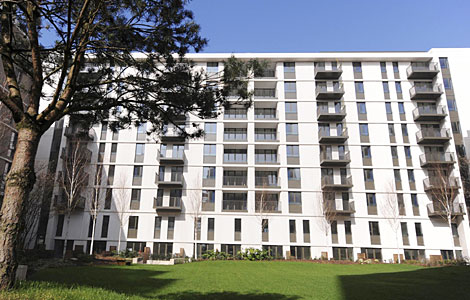
|
